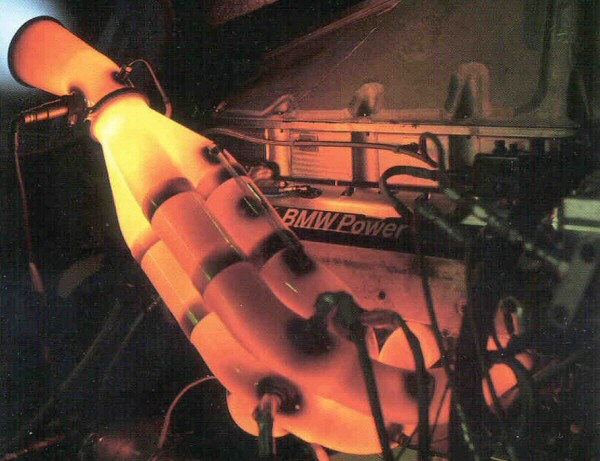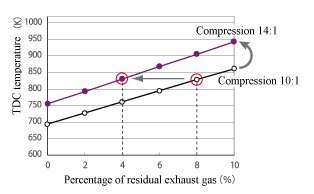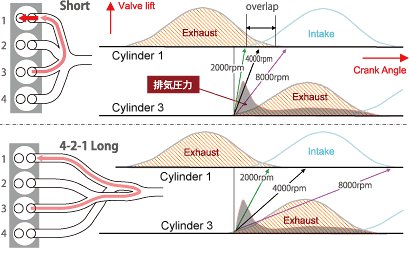 05-01-2011, 11:34 AM
05-01-2011, 11:34 AM
|
#61 (permalink)
|
|
Master Ecomadman
Join Date: Nov 2010
Location: Chicago area
Posts: 1,156
Thanks: 20
Thanked 337 Times in 227 Posts
|
Yes, a low restriction exhaust saves gas and Loud exhausts are just annoying. Not talking tuned pipes or anything, just putting larger exhaust tube and quiet muffler with larger inlet/outlet when original rusts out. I get a kick of the silliness of these youngsters with a loud 4 inch mufflers on a newer car.
__________________
- Tony

|
|
|

|
 Today Today
|
|
|
|
 Other popular topics in this forum...
Other popular topics in this forum...
|
|
|
|
 05-01-2011, 11:40 AM
05-01-2011, 11:40 AM
|
#62 (permalink)
|
|
Moderate your Moderation.
Join Date: Nov 2008
Location: Troy, Pa.
Posts: 8,919
Pasta - '96 Volkswagen Passat TDi 90 day: 45.22 mpg (US)
Thanks: 1,369
Thanked 430 Times in 353 Posts
|
Quote:
Originally Posted by arcosine

Yes, a low restriction exhaust saves gas ... Not talking tuned pipes or anything, just putting larger exhaust tube and quiet muffler with larger inlet/outlet when original rusts out.
|
I've seen plenty of data to refute this claim, but have yet to seea meaningful test which supports it, EXCEPT in the case of a tuned exhaust.
__________________
"¿ʞɐǝɹɟ ɐ ǝɹ,noʎ uǝɥʍ 'ʇı ʇ,usı 'ʎlǝuol s,ʇı"

|
|
|

|
|
The Following User Says Thank You to Christ For This Useful Post:
|
|
 05-02-2011, 07:45 PM
05-02-2011, 07:45 PM
|
#63 (permalink)
|
|
Master EcoModder
Join Date: Jul 2008
Location: Silly-Con Valley
Posts: 1,479
Thanks: 201
Thanked 262 Times in 199 Posts
|
Part of the problem is defining "low restriction". After all, a 4" pipe that's 6" long has very little restriction on a 7-liter motor running 9000 RPM, right? It does offer restriction to a 1.5L motor running at 2000 RPM, because the velocity absolutely sucks at that flow rate.
The 1" pipe that is 4 feet long would likely offer less restriction to the little motor at low RPM than the big fat pipe does. But it would offer a whole lot more to the big motor at high RPM.
So, "low restriction" seems to be a very general term that can mean a lot of different things to different people.
-soD
|
|
|

|
|
The Following User Says Thank You to some_other_dave For This Useful Post:
|
|
 05-02-2011, 08:59 PM
05-02-2011, 08:59 PM
|
#64 (permalink)
|
|
Depends on the Day
Join Date: Nov 2007
Location: Kansas City Area
Posts: 1,761
Thanks: 31
Thanked 41 Times in 35 Posts
|
I generally refer to a great article at TeamIntegra Forums: it's a great description of exhaust pipe diameter, length, muffler choice, explanation of backpressure, etc.
Exhaust Basics
If you click on the "Exhaust Systems" link at the bottom of that page, there are more advanced articles on the topic.
RH77
__________________
“If we knew what we were doing, it wouldn't be called research” ― Albert Einstein
 _
 _

|
|
|

|
 05-03-2011, 09:24 AM
05-03-2011, 09:24 AM
|
#65 (permalink)
|
|
Master Ecomadman
Join Date: Nov 2010
Location: Chicago area
Posts: 1,156
Thanks: 20
Thanked 337 Times in 227 Posts
|
Thats for kindergärtners, read this:
 Exhaust System Technology: Science and Implementation of High Performance Exhaust Systems
Exhaust System Technology: Science and Implementation of High Performance Exhaust Systems
So we see that a tuned header can increase the charge induced into the cylinder at a specific rpm. That does not translate into increased MPG due to higher intake manifold vacuum which is probably not overcome by the lower cylinder pressure at exhaust valve closing.
__________________
- Tony

Last edited by arcosine; 05-03-2011 at 09:37 AM..
|
|
|

|
 06-13-2011, 12:19 AM
06-13-2011, 12:19 AM
|
#66 (permalink)
|
|
Banned
Join Date: Feb 2008
Location: california
Posts: 1,329
Thanks: 24
Thanked 161 Times in 107 Posts
|
Quote:
Originally Posted by dcb

Who says the exhaust is solely (or even partly) responsible?
|
Quote:
Higher compression ratio brings higher combustion efficiency hence power. That's why automotive engineers want to raise compression as high as possible. However, a compression too high will lead to early explosion of fuel-air mixture, or what we call "knocking". Knocking is bad to engines, not only because it causes NVH but also it reduces output. When I started reading about cars, most engines in the world ran at lower than 10:1 compression. As engine management and valve-timing technology improves, nowadays the figure can be higher than 11:1. Direct injection engine may even lift that figure to 12:1 or so thanks to its cooling effect, but anything higher than that remains a dream. However, Mazda made a breakthrough with its Skyactiv-G engine in 2010. It works at an incredible 14:1 compression !
How can Mazda avoid knocking ? A crucial factor causing knocking is the high temperature of combustion chambers. Temperature in the chamber rises during compression stroke. It peaks when the piston reaches the top dead center (TDC, i.e. the highest position). At this point, knocking is most likely to occur. Obviously, if we want to reduce the risk of knocking, we had better to lower the combustion chamber temperature.
Then why is the combustion chamber so hot ? One of the reasons is the existence of residual exhaust gas, i.e. the exhaust gas that flows back into the combustion chamber during the intake stroke just before the exhaust valves close. No one can completely get rid of residual exhaust gas, because for high breathing efficiency engines always need to run with a certain level of valve overlapping (overlapping between the opening period of intake and exhaust valves). Suppose exhaust gas is 750degC and the fresh intake air is 25degC, and their mixture ratio is 1 to 10, you can see the residual exhaust gas can raise the combustion chamber temperature a lot. The more the amount of residual exhaust gas, the higher the combustion chamber temperature is. In other words, if we want to reduce temperature, we can reduce the amount of residual exhaust gas in the combustion chamber.

The graphs above show that a 14:1 compression engine always has higher comnbustion chamber temperature than a 10:1 engine on a given residual exhaust gas level. However, if the amount of residual exhaust gas is reduced to 4 percent, combustion chamber temperature will be about the same as a 10:1 engine running with 8 percent of residual exhaust gas. Now the question is: how to lower the percentage of residual exhaust gas ?
Surprisingly, Mazda uses a very conventional method to do that: a long, 4-to-2-to-1 exhaust manifold. On a typical inline-4 cylinder engine with short, 4-to-1 exhaust manifolds (the first picture below), once the exhaust valve of Cylinder 3 opens, its exhaust pressure waves (grey area) flows through the short manifolds to the exhaust valve of Cylinder 1, which is at the end of its exhaust phase. This pumps some exhaust gas back into Cylinder 1 and becomes residual exhaust gas. When the engine is running at low speed (2000 rpm in the picture below), the exhaust pressure wave arrives Cylinder 1 early enough to cause high percentage of residual exhaust gas. As engine rev rises, the opening and closing of valves speeds up as well, thus the exhaust pressure waves of Cylinder 3 reaches Cylinder 1 at later stage, causing lower percentage of residual exhaust gas. In short, from low to mid-range engine speed the level of residual exhaust gas is pretty high for this engine configuration.

In the case of Skyactiv-G's 4-2-1 exhaust manifolds (the second picture above), exhaust pressure waves from Cylinder 3 has to travel a long way to reach Cylinder 1, by the time Cylinder 1 has already, or nearly completed its exhaust phase. Therefore the level of residual exhaust gas is much lower than the previous case, especially for low to mid-range rpm. As a result, the Skyactiv-G engine attains lower temperature in its combustion chambers and allows a higher compression ratio to be used.
|
AutoZine Technical School - Engine
|
|
|

|
|
The Following User Says Thank You to tjts1 For This Useful Post:
|
|
 06-13-2011, 01:22 AM
06-13-2011, 01:22 AM
|
#67 (permalink)
|
|
Depends on the Day
Join Date: Nov 2007
Location: Kansas City Area
Posts: 1,761
Thanks: 31
Thanked 41 Times in 35 Posts
|
Quote:
Originally Posted by tjts1

AutoZine Technical School Article
|
With respect to many 4-cylinder engines produced in the last 10-15 years, valve overlap has proved to be quite common -- also the compact (and likely inexpensive) design of the 4-1 header is often bolted to these blocks. I recall during my "not-so-Eco-Modding" days that the 4-2-1 header was advertised as one of the first places to start with improving performance (especially in the Honda B-Series) -- whether that can be Scientifically backed, is another question.
The question then becomes, would a specifically tuned 4-2-1 header offer appreciable FE gain for the average inline-4, without any other mods to increase compression?
-RH77
__________________
“If we knew what we were doing, it wouldn't be called research” ― Albert Einstein
 _
 _

|
|
|

|
 06-13-2011, 06:12 AM
06-13-2011, 06:12 AM
|
#68 (permalink)
|
|
EcoModding Lurker
Join Date: Apr 2010
Location: texas
Posts: 24
Thanks: 2
Thanked 6 Times in 4 Posts
|
Excellent thread! Anyone planning on testing the ideas here? I remember seeing a muffler you could adjust backpressure on for mustangs a long time ago. I've been looking at a flowmaster 60 series. Anyone have an idea on what it's effect would be on civic? Originally I was looking at some lightweight exhaust as part of my overall weight reduction program but all the lightweights all sound like giant pissed off bumble bees. I just can't drive a car that sounds like that. cheers-GW
__________________
[url=http://ecomodder.com/forum/emgarage.php?do=edit&vehicleid=5154]
|
|
|

|
 11-05-2011, 02:37 AM
11-05-2011, 02:37 AM
|
#69 (permalink)
|
|
Lead-footed Econewbie
Join Date: Apr 2009
Location: Wellington, New Zealand
Posts: 52
Ceffy - '97 Nissan Cefiro 25 excimo 90 day: 25.21 mpg (US) Demio - '07 Mazda Demio Sport 90 day: 30.99 mpg (US)
Thanks: 4
Thanked 6 Times in 2 Posts
|
Well ghostwalker, I may be trying this out.
Good thread but whats missing is the real world testing, at least from someone who doesn't have a product to sell.
I would still love to see some data, not necessarily showing FE improvements, but showing that there is meaningful backpressure in an exhaust system at light loads and normal driving RPM ranges. With that demonstrated, some improvement in FE could be found by reducing backpressure without fiddling with other aspects of the exhaust tune. Perhaps then it's still only something for a master ecomodder looking to get every last little bit out of their mill.
I have a V6 with a 3-2-1, and the 2-1 is *very* restrictive, with a U-bend looping back on itself, and a tiny outlet into the main cat. It makes the engine much quieter. I still don't understand how and why this has been designed like this, since I imagine at low RPM it's sending exhaust back into the cylinders. I'd love some explanation on that.
On this Nissan VQ engine, an well known aftermarket "y-pipe" mod shows improvement in before and after dyno charts as low as the dyno pull will go, usually 1750rpm. Most show "area under the graph" improvement from 2200 upwards, topping out at about 7-10% improvement, which shows this damn thing really chokes the exhaust flow right down low. Now dyno runs are at WOT of course... so is it still unrealistic in this circumstances to see improvement in normal driving?
Can any of the more knowledgeable folk here say that reducing exhaust restriction, without changing tuned lengths and diameters really isn't worth while? If I get some low end torque in a automatic, there's a also little to be gained in avoiding kickdown?
This mod is good for ~10% power on an otherwise stock engine, is cheap, affects the whole power band ... it's going to be fun bang for buck at worst, and at best is a mod that might get a whisker of FE back.
I will be getting a before and after dyno done. I'll consider doing FE testing and post a proper thread.
|
|
|

|
 11-05-2011, 04:51 AM
11-05-2011, 04:51 AM
|
#70 (permalink)
|
|
Master EcoModder
Join Date: Oct 2011
Location: Los Angeles
Posts: 588
Thanks: 59
Thanked 59 Times in 47 Posts
|
These mileage gains are certainly possible with my car, but the exhaust itself would only be the proximate cause of the increase. Essentially, by adding power, the car would be able to cruise at a given speed under a lower load percentage. By reprogramming the ECU to take advantage of that particular load/rpm range, additional mileage could be achieved.
I don't know if any of that increased mileage could be realized without actually retuning the car to take advantage of the new exhaust. Also, many other factors may come into play, such as naturally aspirated versus turbocharged engines.
__________________

|
|
|

|
|